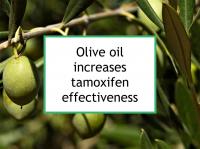Consumption of olive oil has been linked to reduced breast cancer risk. One meta-analysis of data from 19 previous case-control studies found that the highest level of olive oil consumption was associated with approximately half the risk of developing breast cancer compared to the lowest level.
In addition, olive oil has been shown to increase the treatment effects of aromatase inhibitors, paclitaxel and trastuzumab (Herceptin). It appears to be the phenolic compounds in virgin olive oil, not oleic acid (the main fat component), that are responsible for its most of its anti-cancer effects. Now a new study has reported that the extra-virgin olive oil compound oleocanthal inhibits estrogen receptor positive (ER+) breast cancer growth and increases the effectiveness of tamoxifen.
Olive oil and breast cancer
High consumption of olive oil has been found to reduce breast density. Olive oil has also been shown to reduce the aggressiveness of breast cancer in cell and animal studies. Laboratory studies have documented specific olive oil-induced molecular changes in cancer cells and tumors, including changes in the composition of cell membranes, signaling proteins and gene expression. These changes appear to result in lower proliferation and increased apoptosis (programmed cell death) of breast cancer cells, as well as enhanced protection against DNA damage. Diets high in extra-virgin olive oil have been reported to prevent mammary tumor development and growth in animal models of breast cancer compared to high corn oil diets. The phenolic compounds present in olive oil are strong antioxidants and free radical scavengers and have been shown to have anti-cancer effects in breast cancer cells. Oleic acid has been shown to increase the bioavailability of beta-carotene in the diet, which increases the anti-cancer effects of high-beta carotene foods.
However, as noted above, oleic acid does not appear to drive most of olive oil's anti-cancer effects. While oleic acid has anti-inflammatory properties, it has also been shown to induce migration and proliferation of both ER+/PR+ and triple negative breast cancer cells. These findings imply that the protective properties of olive oil are mainly due to other components of the oil.
Extra-virgin olive oil is best
Olive oil is a mostly unsaturated edible oil consisting primarily of oleic acid (an omega-9 monounsaturated fatty acid), linoleic acid (an omega-6 fatty acid), palmitic acid, and stearic acid, as well as a variety of polyphenols (a diverse group of aromatic compounds). Extra-virgin olive oil contains at least 30 phenolic compounds. Included are some familiar flavonoids (apigenin, luteolin) and phenolic acids (caffeic acid, p-coumaric acid, vanillic acid, ferulic acid). However, the main phenolic compounds are oleuropein, oleocanthal, hydroxytyrosol and tyrosol. This highlights the importance of using extra-virgin olive oil (from the first pressing) rather than later pressings or more processed and refined olive oil, which tend to have less or very little phenolic content. In fact, highly refined olive oil might not be beneficial.
Latest research finds oleocanthal potentiates tamoxifen
The study referenced at the beginning of this news story was designed to investigate the effects of (-)-oleocanthal (oleocanthal) treatment on growth of luminal breast cancer cells and to examine the impact of combining oleocanthal with tamoxifen. Oleocanthal was found to inhibit the growth of BT-474 (ER+/PR+/HER2+), MCF-7 (ER+/PR+/HER2-) and T-47D (ER+/PR+/HER2-) human breast cancer cells. Oleocanthal also suppressed the growth of these cell types when 17β-estradiol (estrogen) was added to the growth media. Combining oleocanthal with tamoxifen resulted in increased growth inhibition compared to tamoxifen alone in all three cell lines. Additional experiments demonstrated a great deal of overlap between oleocanthal and 17β-estradiol in binding to estrogen receptors, whereas oleocanthal and tamoxifen were found to have somewhat different binding profiles.
The authors also performed experiments using an animal model of HER2+ breast cancer (mice bearing BT-474 tumor xenografts). Treatment with oleocanthal resulted in 97% inhibition of tumor growth in the mice compared to untreated control animals. Oleocanthal reduced total levels of estrogen receptors in both BT-474 cells and BT-474-derived tumors. The authors conclude that oleocanthal had a beneficial effect in suppressing the growth of ER+ breast cancer and increasing sensitivity to tamoxifen treatment. These findings suggest that evaluating the effect of oleocanthal in combination with endocrine treatments could be worthwhile, according to the authors.
